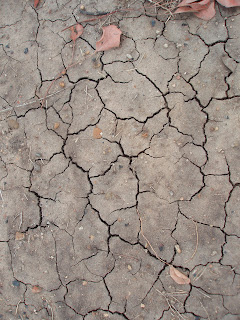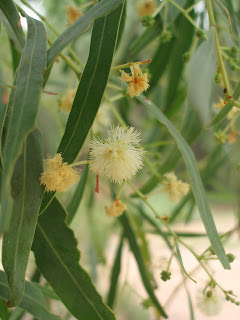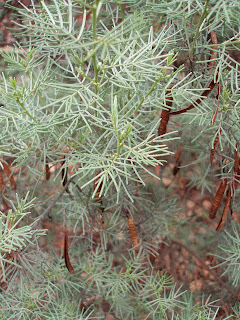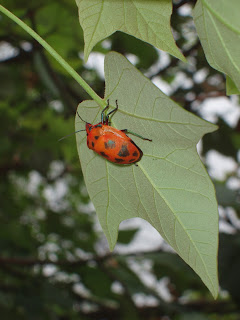There was no apple picking to be done the other day due to the rain so I took a 400km round road trip (not far in Aussie terms) to the inland boarder town of Goondiwindi (pronounced gunned-a-windy) to take a look at the Botanic Garden of the Western Woodlands. On first appearance they were sparse, dry and not particularly colourful. Unlike the majority of Australia’s botanic gardens located on the coastal fringes and displaying a wide variety of species and cultivated plants from around the world, Goondiwindi Botanic Garden features only native plants from the local regions of southern outback Queensland and northern outback New South Wales. The plantings in the garden represent 27 defined botanical habitats from ranging from the western slopes of the Great Dividing Range across the dry planes to deserts of the interior. All of the plants from these regions have adapted to endure prolonged periods of drought and on rare occasions may be submerged of weeks or months at a time when deluges from the tropics slowly make their way down the dry inland creek systems flooding their way slowly south to Lake Eyre and some years all the way to the Southern Ocean, as has happened this year. The town of Goondiwindi received very little rain from the skies though the Macintyre river rose to 10.63 meters above normal levels coming within a few inches of the top of the towns levies.
Goondiwindi Botanic Garden of the Western Woodlands
The grass in the garden was golden, crisp and fissured with cracks as the soil dries and contracts. The plantings are more like that of an arboretum, as the spacing of the plants is critical for the survival of the collection. This is how they would occur in habitat as there wouldn’t be enough moisture in the ground in dry times to maintain a continuous canopy. The garden was conceived in 1986 and it was envisaged right from the very start that it would be a showcase for native floras. The first plants went in the ground in 1988 and several thousand trees and shrubs have been planted since that time. A large percentage of plants have been lost to drought and replaced. Drought cycles may be ten years or more and young plants don’t make it through these times. Young plants are mulched and are helped with trickle irrigation but the loss of some plants, it seems, is the reality of gardening in this region. The original time scale for the evolution of the garden was planned in decades as apposed to years as many under story shrubs and delicate ephemeral plants will only be able to survive once a mature over story has been established.
The drought in Goondiwindi persists in any regions beyond the towns flood levies.
The main canopy colour is silver to glaucus green although some trees like the Queensland Lacebark Brachychiton discolor with its swollen bottle shaped trunk to act as a reservoir looked distinctly glossy, lush and green among it’s counterparts. Being high summer now there were no trees or shrubs putting on grand floral displays as blousy water hungry petals would get burned to a crisp in no time. On closer inspection there were plenty of species in flower, filling a niche, the majority of which are comprised of only the bare essentials.
Callostemma purpureum (Garland Lilly) and (Bauhinia) Latin name unknown
Eremorphila neglecta ‘Olive’ and Callistemon ‘Injume Pink’
Acacia salicina (Doolan) and Acacia species
Eremorphila polyclada and Eucalyptus species
The main foliage type is schlerophyll (tough leaved) like those of Eucalyptus species and often their colour is glaucus or silver. Eremorphila glabra ‘Compacta’ has small hairy leaves held close to the stems. Others like Cassia artemesioides (Silver Cassia) have reduced their leaves to needles and Hakea purpurea has done away with leaves all together photosynthesising through the green stems.
Cassia artemesioides (Silver Cassia) and Eremorphila glabra ‘Compacta’
Hakea purpurea and silver foliage, plant unknown
Many of the more showy early flowering trees are now shedding their seeds. The flowering of Brachychiton species are supposed to be spectacular and it is often used as an ornamental in parks and gardens. I’ve yet to see one in full bloom.
Brachychiton discolor (Queensland Lacebark) and Senna circinnata (Spring Pod Cassia)
Pittosporum phylliraeoides (Native Apricot) and black seeds, unknown plant
Another adaptation to cope with the harsh environment is to develop symbiotic relationships like the ants living inside the galls on the Acacia pendula which help defend the tree against browsing and aid pollination. Unfortunately not all the ants live in the trees and I seem to have developed the knack stopping to take photos right on top of their nests.
Acacia pendula (Myall) with ant gall and Brachychiton discolor (Queensland Lacebark) leaf and Shield Bug
Brachychiton rupestris (Bottle Tree) leaves made into spider nests and a row of eggs on a leaf
Here is a bit about Lake Eyre.
There is still a few months of apple picking to be done, then my plan was to travel inland to the Simpson Desert for a week or so then double back and head north to the tropics of northern Queensland. These plans may change and I may now turn south and follow the inland creeks down to Lake Eyre to see the transformation of the floods, the greening of the desert and the accompanying boom in wildlife. Not having a four wheel drive I’m not yet shore how feasible this plan would be, but there is still plenty of time to research and make a decision.





































